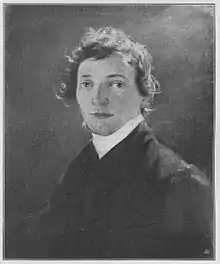Friedrich Schilcher
Friedrich Schilcher (1811 – 1881) was an Austrian portrait, genre, and history painter, and decorative designer.
Friedrich Schilcher | |
|---|---|
 Portrait of Friedrich Schilcher by Friedrich von Amerling | |
| Born | 1 September 1811 Vienna, Austria |
| Died | 6 May 1881 (aged 69) Vienna, Austria |
| Nationality | Austrian |
| Occupation | Painter |
Schilcher was born in Vienna on 1 September 1811. He studied at the Vienna Academy, undertook study trips to Hungary and Transylvania, and became the president of Vienna Künstlerhaus.[1] He died on 6 May 1881 at Unterdöbling in Vienna, and was buried in the Vienna Central Cemetery. In 1975 the Schilchergasse (street) in Vienna's 14th borough of Penzing, was named after him.[2][3][4]
Works
- restoration of ceiling frescoes by Marcantonio Chiarini in the Winter Palace of Prince Eugene, Innere Stadt, Vienna (1841)
- restoration of ceiling frescoes in the Great Boardroom of Palais Niederösterreich, Vienna
- stage curtain for the Hungarian National Theatre, Budapest
- altarpiece for the Ladislauskirche, Oradea, Romania
- Cardinal virtues, frescoes in the prelate courtyard of Melk Abbey (1852)
- Glory of Saint Benedict, ceiling painting for the entrance hall at Melk Abbey (1852)
- The circular dance of angels, painting behind the high altar at St Joseph's Church in Kahlenberg, Vienna (1852)[5]
- painting for the Finsterle family mausoleum in the parish cemetery at Kahlenbergerdorf in Döbling, Vienna
- decoration in the parish church of Leobersdorf (1859-1862)
- portrait of Franz Joseph I of Austria of Austria (1860), oil on canvas, 123 × 95 cm
- ceiling painting in the 'Schubert Room' at the Palais Dumba, Vienna, depicting aspects of Schubert's work, for Nikolaus Dumba[1][6]
- supraport frescoes for the Palais Schwarzenberg, Vienna
- figurative painting for the curtain of the Theater an der Wien (1864)[7]
- Allegory of Austria, fresco in the Great Dining Room of the Austria Classic Hotel Wien, Vienna (destroyed 1945)
- portrait of Johann II, Prince of Liechtenstein (Collection Liechtenstein, inv. No. GE 1841), oil on canvas, 55.4 × 47.4 cm
Further paintings are in the Vienna Museum and the Academy of Fine Arts Vienna.
Bibliography
- Constantin von Wurzbach: Schilcher, Friedrich. In: Biographisches Lexikon des Kaiserthums Oesterreich (Biographical Lexicon of the Empire of Austria). Part 29 Kaiserlich-königliche Hof- und Staatsdruckerei, Vienna 1875, p. 312–314 (digitalised).
References
- Tzafettas, John; Konecny, Elvira (2015); "Chapter 5 – The Dumba Palace, Palais Am Parkring" in Nikolaus Dumba (1830-1900): A Dazzling Figure in Imperial Vienna : Maecenas of Music and Fine Art, National Benefactor of Austria and Greece, Akakia Publications
- Zeitschrift für allgemeine Museologie und verwandte Wissenschaften (1878), Dresden, W. Baensch, p.80; “The painter Friedrich Schilcher died on the 6th of December in Unter-Döbling near Vienna". Retrieved 29 December 2020
- Neumann, Wilhelm, 1849-1919; Gemälde-Sammlung, Friedrich Wilhelm Brederlosche (1894), Beschreibendes Verzeichnis der Gemälde der Friedrich Wilhelm Brederloschen Sammlung zu Riga, Riga, W.F. Häcker, p.78. Retrieved 29 December 2020
- "Friedrich Schilcher" in Führer durch die Gemäldegalerie (1906), Kunsthistorisches Museum Wien, Gemäldegalerie, p.600. Retrieved 29 December 2020
- Schnerich, Alfred (1921); Vienna's churches and chapels : in art and cultural-historical representation, Amalthea Verlag, Zurich, pp.219,220
- Clive, Peter (1997); Schubert and his World: A Biographical Dictionary, Clarendon Press, pp.41,42. ISBN 019816582X
- "Theater an der Wien", Theatre-architecture.eu, Theatre Database. Retrieved 29 December 2020
External links
 Media related to Friedrich Schilcher at Wikimedia Commons
Media related to Friedrich Schilcher at Wikimedia Commons- "Works of Art", Friedrich Schilcher (österreichisch, 1811–1881), on Artnet
This article is issued from Wikipedia. The text is licensed under Creative Commons - Attribution - Sharealike. Additional terms may apply for the media files.